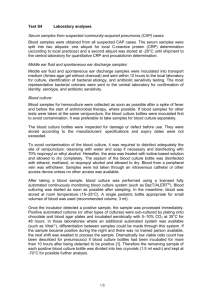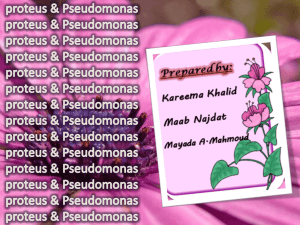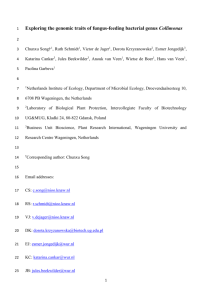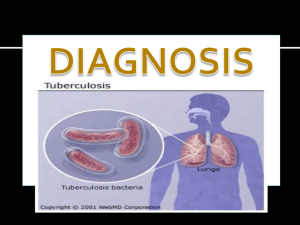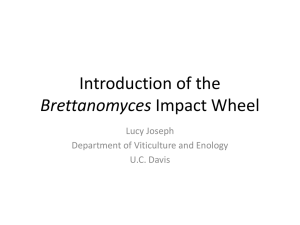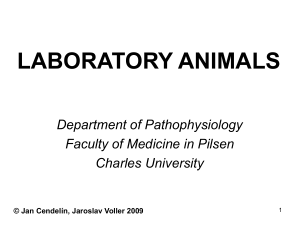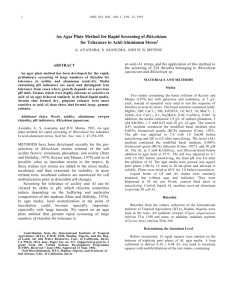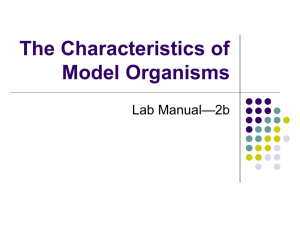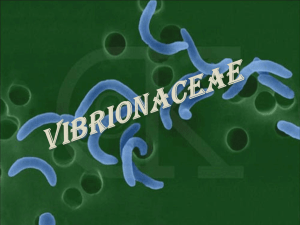Pseudomonas
advertisement
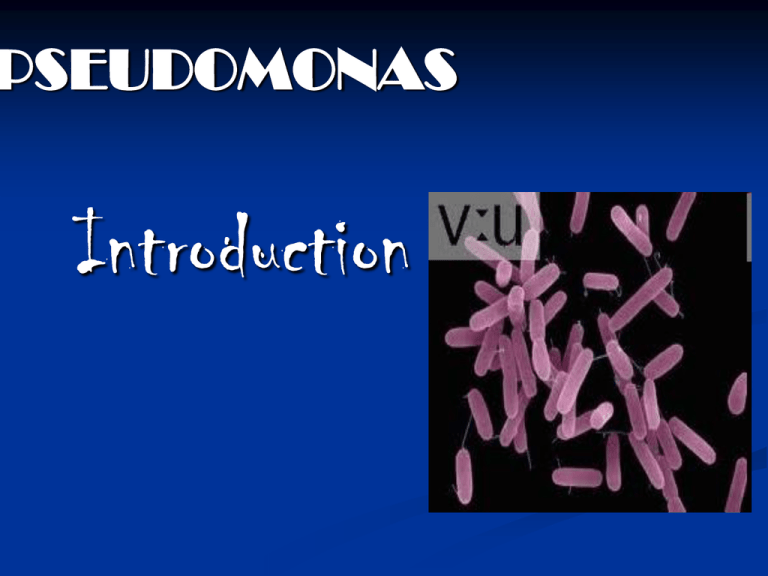
PSEUDOMONAS Introduction Large group of aerobic non sporing gram negative motile by polar flagella ubiquitous oppurtunistic infections newer genera-Burkholderia Stenotrophomonas Species Pseuomonas aeruginosa Stenotrophomonas maltophila Burkholderia cepacia Burkholderia mallei Burkholderia pseudomallei Pseudomonas aeruginosa Morphology slender,Gram negative bacillus size-1.5 microns-3*1.5microns motile by polar flagella non capsulated though some mucoid strains may sometimes occur some are pilated Cultural characteristics Obligate aerobe Wide range of temperature 5°c-42°c optimum 37°c Ordinary media – large,opaque,irregular,with distinctive musty,mawkish,earthy smell Cont.. Nutrient agar Colonies are smooth,large,translucent,low convex,2-4mm in diameter. Produce sweetish aromatic odour Greenish blue pigment diffuses Cont.. Blood agar Similar to nutrient agar Many are haemolytic Mac conkey agar Colourless,non lactose fermenters Cetrimide agar selective media Pigment production Pyocyanin Bluish green phenazine pigment Soluble in chloroform and water Not produced by other species Pyoverdin(fluorescin) It is a greenish yellow pigment Insoluble in chloroform but soluble in water Produced by many other species Pyocyanin Pyoverdin Cont.. Pyorubin Reddish brown pigment Insoluble in chloroform but soluble in water pyomelanin Brown to black pigment Production is uncommon Biochemical reactions O/F test-oxidative Catalase-positive Oxidase-positive Nitrate reduction-positive Cont.. Indole test-negative Methyl red test-negative Vp test-negative Citrate test-positive Urease test-negative Cont… Sugar fermentation tests Glucose-only acid Lactose-negative Sucrose-negative Mannitol-negative Resistance Susceptible to heat,killed at 55°c in one hour acids beta glutarldehyde Silver salts strong phenolic disinfectants So,silver sulphonamide as a topical cream in burns is used Cont… Resistant to chemical agents common antiseptics disinfectants -ammonium compounds chlroxylenol hexachlorophane antibiotics -aminoglycosides cephalosporins pencillins Antigenic structure O antigens Possesses 19 distinct,group specific O antigens Heat labile H antigens Two heat labile antigens recognised in Ps.aeruginosa Toxins and enzymes Extracellular products Pyocyanin inhibits mitochondrial enzymes and causes disruption and cessation of ciliary beat on ciliated nasal epthelium Extracellular enzymes and haemolysins Produces proteases,haemolysins and lipases Exotoxins Produces two exotoxns A and S Endotoxins It is a lipopolysaccharide have pyrogenic action Typing methods Bacteriocin typing Three types of bacteriocins are produced-R,F,S Pyocin produced by test strain is employed to assess the growth inhibition of 13 Depending upon the growth inhibition of 13 indicators strains,105 types are recognised Most popular method used Cont.. Phage typing Serotyping based on O and H,17 serotypes of Ps.aeruginosa are recognised Molecular Method Restriction endonuclease typing with pulsed-field gel electrophoresis(PAGE) is most reliable PATHOGENESIS Important agent in causing nosocomial infections Most common infections are Urinary tract infections following catheterisation Acute purulent meningitis following lumbar puncture Post-tracheostomy pulmonary infection Septicaemia in debilitated patients cont.. Wound and burn infections Chronic otitis media and otitis externa Eye infections Acute necrotising vasculitis Infantile diarrhoea Mechanism Of Pathogenesis Caused by exotoxins,proteases,elastases,haemolysins,lip ases and enterotoxins Exotoxin A-lethal toxin Elastases-haemorrhagic lesions Enterotoxins-diarrhoeal disease Slime layer acts as a capsule and enhances virulence Thank you HAEMOPHILUS INTRODUCTION HAEMOPHILUS INFLUENZAE MORPHOLOGY SMALL [ 1.0 X 0.3 MICRONS] GRAM NEGATIVE NON MOTILE NON SPORING EXHIBIT PLEOMORPHISM CULTURAL CHARACTERISTICS FACTOR X FACTOR V HEAT STABLE HEAT LABILE HEMIN BACTERIAL VITAMIN AEROBIC RESPIRATION ANEROBIC RESPIRATION CONT… AEROBIC GROWS ANEROBICALLY ALSO OPTIMUM TEMPERATURE-37C SOME STRAINS REQUIRE 10% CO2 BLOOD AGAR-SCANTY GROWTH SATELLITISM Staph.aureus is streaked across a plate of blood agar on which a specimen containing H.influenzae has inoculated After overnight incubation Colonies large -along the streak of Staph.aureus small –farther away satellitism CONT… LEVINTHAL`S MEDIUM Boiling and filtering a mixture of blood and nutrient broth Capsulated strains produce translucent colonies FILDES AGAR By adding a peptic digest of blood to nutrient agar Best for primary isolation Copious growth BIOCHEMICAL REACTIONS Catalase-positive Oxidase-positive Glucose,Xylose-fermented with acid production Lactose,Sucrose,Mannitol-not fermented RESISTANCE Destroyed by heating refrigeration drying disinfectants Cultures may be preserved for about a month on choclate agar slopes in screw capped bottles Long term preservation –culture may be lyophilised ANTIGENIC PROPERTIES 3 Major surface antigens Capsular polysaccharide Outer membrane protien Lipo oligosaccharide Major antigenic determinant of capsulated strains Capsular polysaccharide Pittman classified into 6 capsular strains i.e type a to f •Meningitis belong to type b strain •Type b strain contains pentose sugars ribose &ribitol instead of hexoses & hexosamines in other 5 serotypes •Capsular polyribosyl ribitol phosphate antigen of Hib induces IgG IgM IgA antibodies which are bactericidal and protective CONT…. Strains lacking a capsule cannot be typed and are called NON TYPABLE STRAINS Outer membrane protein antigens of H influenzae type b have been classified into 13 sub types Lipo oligosaccharides are antigenically complex PATHOGENECITY Exclusively human pathogen Not pathogenic for animals but intra peritoneal inoculation of large doses is fatal in mice,guinea pigs &rabbits Diseases due to H influnzae considered under 2 groups –invasive and non invasive INVASIVE •Spread through Blood NON INVASIVE •Spread through local invasion •Meningitis,arthritis, •Otitis media,sinusitis endocardits,conjuctivit is,pancarditis •Seen in children •Seen in adults •Caused by capsulated •Caused by non strains capsulated strains CLINICAL MANIFESTATIONS MENINGITIS Bacilli reach meninges from nasopharynx through blood stream Common in children LARYNGO EPIGLOTTIS Acute inflammaton of epiglottis with obstructive laryngitis Children above 2 years CONT…. PNEUMONIA Infants accompanied by empyema Older children & adults by lobar pneumonia These are primary infections due to capsulated strains Broncho pneumonia may occur as secondary infection due to non capsulated strains CONT… SUPPURATIVE LESIONS Arthritis,endocarditis& pericarditis may result from hematogenous dissemination Otitis media occurs by direct spread from nasopharynx BRONCHITIS Associated with pneumococci in acute exacerbationof chronic bronchitis &bronchiectasis LAB DIAGNOSIS 1.SPECIMENS CSF Blood Throat swab Sputum Pus Aspirates from joints ,middle ears 2.COLLECTION &TRANSPORT Collected in sterile containers & under aseptic conditions Very sensitive to low temp so should not be refrigerated Transported to laboratory with out delay Inoculated on culture media immediately CONT..... 3.DIRECT MICROSCOPY Gram staining Immunoflouroscence and quellung reaction Antigen detection Latex agglutination Co-agglutination Counter immuno electrophoresis CONT… 4.CULTURE CSF culture Blood culture Sputum culture 5.COLONY MORPHOLOGY AND STAINING 6.SEROTYPING TREATMENT Cefotaxime & Ceftazidime is the drug of choice for meningitis Ampicillin &Cotrimoxazole –respiratory infections Amoxycillin - clavulanate or clarithromycin is more effective EPIDEMIOLOGY & PREVENTION Infection transmitted by respiratory route Immunity is type specific Active immunization with Hib PRP vaccine is indicated Conjugate Hib PRP is used for younger children Rifampicin -4 days prevents secondary infection in contacts & also eradicates carrier state Haemophilus aegyptius KOCH –WEEKS BACILLUS Non capsulated Causes highly contagious form of conjuctivitis [ pink eye ] Causative agent of Brazilian purpuric fever [BPF] Responds to local sulphanamides & gentamicin Haemophilus ducreyi Ducrey demonstrated in chancroid lesions Short ,ovoid bacillus Gram nagative often may appear gram positive & frequently show bipolar staining May be arranged in small groups or whorls or in parallel chains giving a SCHOOL OF FISH or RAIL ROAD TRACK appearance CONT… Can be grown on fresh clotted rabbit blood May also grown on chorio allontioc membrane of chick embryo On choclate agar enriched with isovitalex and fetal calf serum & containing vancomycin as a selective agent Forms small ,grey ,translucent colonies after incubation at 35 c under 10 % co2 & high humidity in 2 – 8 days CONT… Antigenically homogenous Cultures may be identified by agglutinatoin with anti serum Susceptible to sulphonamides & many antibiotics Erythromycin ,Cotrimoxazole ,Ciprofloxacin may be used for treatment Choclate agar Haemophilus parainfluenzae Requires factor V & not the factor X Commensel in the upper respiratory tract Causes bacterial endocarditis ,urethritis ,acute pharyngitis Haemophilus haemolyticus Requires both factor X & V Commensal of upper respiratory tract Strains that donot require factor X have been designated as H parahaemolyticus Haemophilus aphrophilus Requires factor X but not factor V Cause bacterial endocarditis ,brain abscess ,sinuisitis pneumonia Strains requiring factor V but not factor X have been termed as H paraaphrophilus HACEK group bacteria Fastidious slow growing bacteria H- Haemophilus species ACE- Cardiobacterium hominis K - Kingella kingae Actinobacillus Eikenella corrodens
